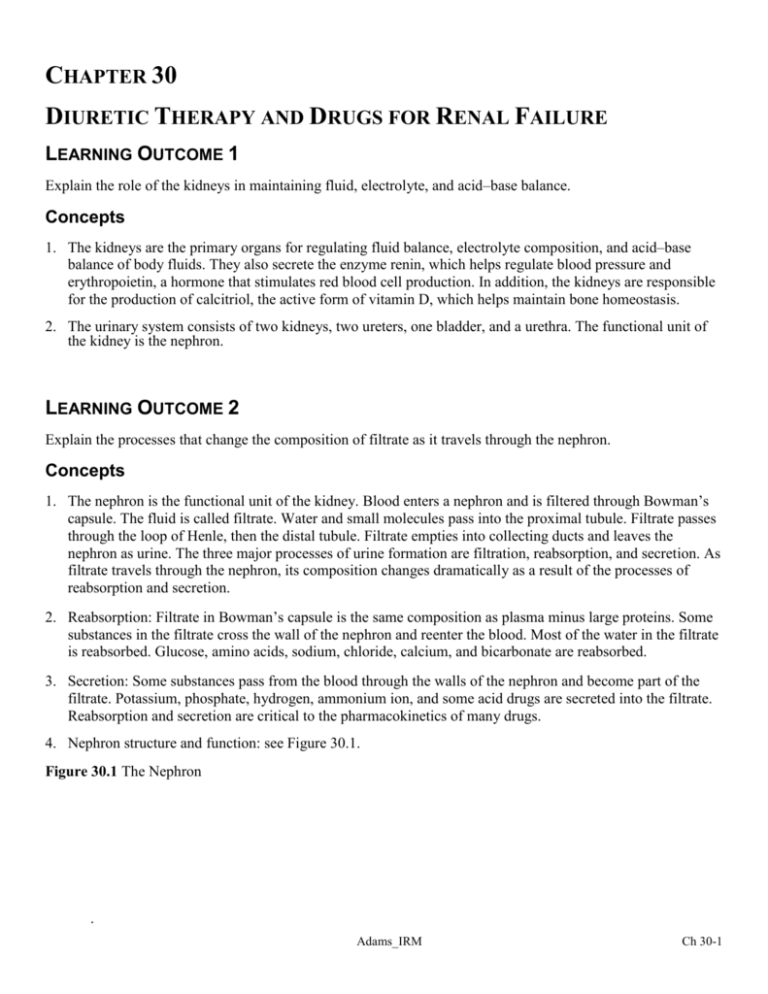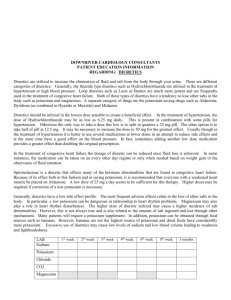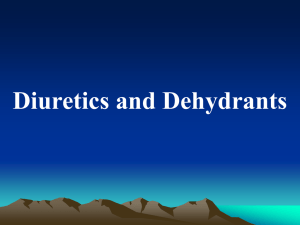CHAPTER 30
advertisement

CHAPTER 30 DIURETIC THERAPY AND DRUGS FOR RENAL FAILURE LEARNING OUTCOME 1 Explain the role of the kidneys in maintaining fluid, electrolyte, and acid–base balance. Concepts 1. The kidneys are the primary organs for regulating fluid balance, electrolyte composition, and acid–base balance of body fluids. They also secrete the enzyme renin, which helps regulate blood pressure and erythropoietin, a hormone that stimulates red blood cell production. In addition, the kidneys are responsible for the production of calcitriol, the active form of vitamin D, which helps maintain bone homeostasis. 2. The urinary system consists of two kidneys, two ureters, one bladder, and a urethra. The functional unit of the kidney is the nephron. LEARNING OUTCOME 2 Explain the processes that change the composition of filtrate as it travels through the nephron. Concepts 1. The nephron is the functional unit of the kidney. Blood enters a nephron and is filtered through Bowman’s capsule. The fluid is called filtrate. Water and small molecules pass into the proximal tubule. Filtrate passes through the loop of Henle, then the distal tubule. Filtrate empties into collecting ducts and leaves the nephron as urine. The three major processes of urine formation are filtration, reabsorption, and secretion. As filtrate travels through the nephron, its composition changes dramatically as a result of the processes of reabsorption and secretion. 2. Reabsorption: Filtrate in Bowman’s capsule is the same composition as plasma minus large proteins. Some substances in the filtrate cross the wall of the nephron and reenter the blood. Most of the water in the filtrate is reabsorbed. Glucose, amino acids, sodium, chloride, calcium, and bicarbonate are reabsorbed. 3. Secretion: Some substances pass from the blood through the walls of the nephron and become part of the filtrate. Potassium, phosphate, hydrogen, ammonium ion, and some acid drugs are secreted into the filtrate. Reabsorption and secretion are critical to the pharmacokinetics of many drugs. 4. Nephron structure and function: see Figure 30.1. Figure 30.1 The Nephron . Adams_IRM Ch 30-1 LEARNING OUTCOME 3 Describe the adjustments in pharmacotherapy that must be considered for patients with renal failure. Concepts 1. Renal failure is a decrease in the ability of the kidneys to function. Drugs can accumulate to high levels in the body. The dosage levels for most medication dosages need to be adjusted. Administering the average dose to a person in renal failure can be fatal. 2. The diagnosis of renal failure is made by analyzing the following diagnostic studies: urinalysis, serum creatinine, diagnostic imaging, renal biopsy, and glomerular filtration rate (GFR). Glomerular filtration rate is the best marker for estimating renal function; it measures the volume of water filtered per minute. 3. Renal failure is classified as acute or chronic, depending on its onset. Acute renal failure requires immediate treatment. The accumulation of waste products can be fatal. The most common cause of acute renal failure is hypoperfusion. The cause must be rapidly identified; some of the usual causes are heart failure, dysrhythmias, hemorrhage, and dehydration. 4. Chronic renal failure occurs over months or years. The patient usually has a history of diabetes mellitus or hypertension. Chronic renal failure may be undiagnosed for a long time. Nephrotoxic drugs can cause acute or chronic renal failure. (See Table 30.1 for a list of nephrotoxic drugs.) 5. Pharmacotherapy for renal failure attempts to cure the cause of the dysfunction. Diuretics are used to increase urine output. Cardiovascular drugs treat hypertension or heart failure associated with renal failure. (See Table 30.2 for the pharmacologic treatment of renal failure.) Dietary management includes restriction of protein and reduction of sodium, potassium, phosphorous, and magnesium. Table 30.1 Nephrotoxic Drugs Table 30.2 Pharmacological Management of Renal Failure LEARNING OUTCOME 4 Identify indications for diuretics. Concepts 1. Diuretics are drugs that alter the volume and/or composition of body fluids. They are indicated for the treatment of HTN, heart failure, and disorders characterized by accumulation of edema fluid. 2. Diuretics increase the rate of urine flow. Excretion of excess fluid is used to treat hypertension, heart failure, kidney failure, liver failure or cirrhosis, and pulmonary edema. Ch 30-2 Adams_IRM LEARNING OUTCOME 5 Describe the general adverse effects of diuretic pharmacotherapy. Concepts Pharmacotherapy with diuretics can cause fluid and electrolyte disturbances. Some of the side effects are dehydration, orthostatic hypotension, and imbalances of sodium and potassium. LEARNING OUTCOME 6 Compare and contrast the loop, thiazide, and potassium-sparing diuretics. Concepts 1. Loop diuretics:The most effective diuretics are called loop or high- ceiling diuretics. Drugs in this class act by blocking the reabsorption of sodium and chloride in the loop of Henle. When given intravenously, they have the ability to cause large amounts of fluid to be excreted by the kidney in a very short time. Loop diuretics are used to reduce the edema associated with heart failure, hepatic cirrhosis, and chronic renal failure. Furosemide and torsemide are also approved for hypertension. (The loop diuretics are shown in Table 30.3.) 2. Thiazide diuretics:The thiazides comprise the largest, most commonly prescribed class of diuretics. These drugs act on the distal tubule to block Na+ reabsorption and to increase potassium and water excretion. Their primary use is for the treatment of mild to moderate hypertension; however, they are also indicated for edema due to mild to moderate heart failure, liver failure, and renal failure. They are less efficacious than the loop diuretics and are not effective in patients with severe renal failure. (The thiazide diuretics are shown in Table 30.4.) 3. Potassium-sparing diuretics:Hypokalemia is one of the most serious adverse effects of the thiazide and loop diuretics. The therapeutic advantage of the potassium-sparing diuretics is that increased diuresis can be obtained without affecting blood potassium levels. This group of diuretics works in one of two ways, either by blocking sodium or by blocking aldosterone. (The potassium-sparing diuretics are shown in Table 30.5.) 4. Miscellaneous diuretics:A few diuretics (shown in Table 30.6) cannot be classified as loop, thiazide, or potassium-sparing agents. These diuretics have limited and specific indications. Three of these drugs inhibit carbonic anhydrase, an enzyme that affects acid–base balance by its ability to form carbonic acid from water and carbon dioxide. The osmotic diuretics include the drug mannitol. It is used to maintain urine flow in patients with acute renal failure or during prolonged surgery. Figure 30.1 The Nephron Table 30.3 Loop Diuretics Table 30.4 Thiazide and Thiazide-like Diuretics Table 30.5 Potassium-sparing Diuretics Table 30.6 Miscellaneous Diuretics Adams_IRM Ch 30-3 LEARNING OUTCOME 7 Describe the nurse’s role in the pharmacologic management of renal failure and in diuretic therapy. Concepts 1. The role of the nurse in the pharmacological management of renal failure and in diuretic therapy involves careful monitoring of a patient’s condition and providing education as it relates to the prescribed drug treatment. The nurse obtains a medical, drug, dietary, and lifestyle history from each patient. Assessment of weight, intake and output, skin turgor and moisture, vital signs (check blood pressure lying, sitting, and standing), breath sounds, and the presence of edema will indicate the effectiveness of the diuretic. 2. Loop (high-ceiling) diuretics: Obtain baseline, and monitor periodically during drug therapy the patient’s lab values, weight, and current level of urine output. It is critical to measure the patient’s electrolytes, especially potassium, sodium, and chloride, prior to loop diuretic therapy. Monitor the patient’s blood urea nitrogen (BUN), serum creatinine, uric acid, and blood-glucose levels. Assess for adverse effects such as circulatory collapse (due to loss of fluid), dysrhythmias, hearing loss, renal failure, and anemia. Orthostatic hypotension, hypokalemia, hyponatremia, and polyuria are additional common side effects. Observe for a rash or pruritis, which can indicate hypersensitivity to loop diuretics. Teach patients to take diuretics in the morning, change positions slowly, and to monitor weight. Patients should take potassium supplements, if ordered, and consume potassium-rich foods. 3. Thiazide and thiazide-like diuretics: Obtain baseline, and monitor periodically during drug therapy the patient’s lab values, weight, and current level of urine output. It is critical to measure the patient’s electrolytes, especially potassium, sodium, and chloride, prior to loop-diuretic therapy. Monitor the patient’s blood urea nitrogen (BUN), serum creatinine, uric acid, and blood-glucose levels. Increased potassium loss may occur when used with digoxin. Patients taking lithium have an increased risk of toxicity when taking thiazide diuretics. Hypersensitivity reactions may occur more frequently in patients who are allergic to sulfa-based medications. These reactions often present as rashes. Use with caution in pregnant women. Do not administer thiazide diuretics to lactating women. Teach patients to use sunscreen to decrease photosensitivity. Patients should take potassium supplements, if ordered, and consume potassium-rich foods, report any tenderness or pain in joints, which may indicate gout. 4. Potassium-sparing diuretics: The advantage of these medications is that the patient will not experience hypokalemia. It is critical to assess electrolytes, especially potassium and sodium levels, prior to administering potassium-sparing diuretics. Monitor the patient’s BUN and serum creatinine. Be alert for adverse effects that may include hyperkalemia and GI bleeding, confusion, dizziness, muscle weakness, blurred vision, impotence, amenorrhea, or gynecomastia. Spironolactone may also decrease the effectiveness of anticoagulants. Patients taking digoxin or lithium may be at increased risk for toxicity when taking potassium-sparing diuretics. Do not use triameterene in lactating women. Teach patients to immediately report signs and symptoms of hyperkalemia, such as irritability, anxiety, abdominal cramping, or irregular heartbeat. Avoid use of potassium-based salt substitutes. When in direct sunlight, use sunscreen to decrease photosensitivity. Avoid performing tasks that require mental alertness until the effects of the medication are known. Do not eat excess amounts of foods high in potassium. Ch 30-4 Assign students to observe in the renal dialysis unit. Have them interview the patients and ask about the types of diuretics they have used. Adams_IRM LEARNING OUTCOME 8 For each of the classes shown in Drugs at a Glance, know representative drugs, and explain the mechanism of drug action, primary actions, and important adverse effects. Concepts 1. The most efficacious diuretics are the loop or high-ceiling agents. The mechanism of action is to block the reabsorption of sodium in the loop of Henle. Prototype drug: furesomide (Lasix); increases urine output even when blood flow to kidney is diminished. Mechanism of action: to block reabsorption of sodium in loop of Henle. Primary use: to treat hypertension and reduce edema associated with heart failure, hepatic cirrhosis, and renal failure. Adverse effects are rapid excretion of large amounts of water dehydration, electrolyte imbalances, and ototoxicity. Other examples: Torsemide, which has a longer half-life than furosemide and offers the advantage of once-a-day dosing; and bumetanide (Bumex), which is 40 times more potent than furosemide but has a shorter duration of action. Loop diuretics are shown in Table 30.3. 2. The thiazides act by blocking sodium absorption in the distal tubule of the nephron and are the most widely prescribed class of diuretics. The prototype drug in this class is chlorothiazide (Diuril). The most common indication for chlorothiazide is mild to moderate hypertension or in combination with other antihypertensives for severe hypertension. It is also used to treat fluid retention due to heart failure, liver disease, and corticosteroid or estrogen therapy. When given orally, it may take as long as four weeks to obtain the optimum therapeutic effect. Adverse effects are dehydration, orthostatic hypotension, and hypokalemia. 3. Though less effective than the loop diuretics, potassium-sparing diuretics are used in combination with other agents; they help prevent hypokalemia. The prototype drug is spironolactone (Aldactone). The mechanism of action is to block the action of aldosterone. The primary use is to significantly reduce mortality in heart failure. The major adverse effect is hyperkalemia. 4. Several less commonly prescribed classes, such as the osmotic diuretics and the carbonic anhydrase inhibitors, have specific indications. Carbonic anhydrase inhibitors such as acetazolamide (Diamox) inhibit formation of carbonic acid. The primary use is to decrease intraocular fluid pressure in patients with glaucoma. Adverse effects can be allergic reactions, as these drugs contain sulfa, and fluid and electrolyte imbalances. 5. Osmotic diuretics such as mannitol quickly reduce plasma volume. They are used to reduce intracranial pressure due to cerebral edema and to maintain urine flow in prolonged surgery, acute renal failure, or severe renal hypoperfusion. Adverse effects include headache, dizziness, tremors, dry mouth, fluid and electrolyte imbalances, and thrombophlebitis. Prototype Drug furosemide (Lasix) chlorothiazide (Diuril) spironolactone (Aldactone) ANIMATIONS AND VIDEOS Mechanism in Action: Spironolactone (Aldactone) Adams_IRM Ch 30-5 LEARNING OUTCOME 9 Use the nursing process to care for patiients who are receiving drug therapy for renal failure and diuretic therapy. Concepts 1. Patients receiving drug therapy for renal failure and diuretic therapy— Assessment: Obtain a complete health history (cardiovascular disease, diabetes, pregnancy, or breast-feeding), including data on recent surgeries or trauma. Obtain patient’s medication history, including nicotine and alcohol consumption and use of herbal supplements or alternative therapies to determine possible drug allergies and/or interactions. Obtain dietary and lifestyle history. Evaluate appropriate laboratory findings such as electrolytes, glucose, CBC, hepatic or renal function studies, uric acid levels, and lipid profiles. Obtain baseline weight, vital signs (especially BP and pulse), breath sounds, and cardiac monitoring (e.g., ECG, cardiac output). Assess for location and character/ amount of edema. Assess baseline hearing and balance. Assess patient’s ability to receive and understand instruction. Assess for and promptly report adverse effects: hypotension, palpitations, dizziness or lightheadedness, musculoskeletal weakness or cramping, nausea, vomiting, abdominal cramping, diarrhea, headache. 2. Patients receiving drug therapy for renal failure and diuretic therapy—Nursing diagnoses: Deficient Fluid Volume related to adverse effects of diuretics; Fatigue; Decreased Cardiac Output related to adverse effects of diuretics; Deficient Knowledge (drug therapy); Risk for Falls; Risk for Injury related to hypotension, dizziness associated with adverse effects; Risk for Functional Incontinence related to diuretic use; Risk for Noncompliance related to adverse effects of drug therapy. 3. Patients receiving drug therapy for renal failure and diuretic therapy—Planning: The patient will experience a decrease in blood pressure. Be free from or experience minimal adverse effects. Verbalize an understanding of the drug’s use, adverse effects and required precautions. Demonstrate proper selfadministration of the medication (e.g., dose, timing, when to notify provider). 4. Patients receiving drug therapy for renal failure and diuretic therapy—Implementation: Continue frequent assessments above for therapeutic effects blood pressure and pulse. Continue to monitor vital signs. Take blood pressure lying, sitting, and standing to detect orthostatic hypotension. Continue to monitor electrolytes, glucose, CBC, lipid profiles, liver function studies, creatinine, and uric acid levels. Continue to monitor hearing and balance, reporting persistent tinnitus or vertigo promptly. Ensure patient safety, especially in the elderly. Observe for lightheadedness or dizziness. Weigh patient daily and report weight gain or loss of 1 kg or more in a 24 hour period. Measure intake and output. Monitor nutritional status and encourage appropriate intake to prevent electrolyte imbalances. Observe for signs of hypokalemia or hyperkalemia. Use with caution in patients taking corticosteroids, ACE inhibitors, angiotensin-receptor blockers (ARBs), digoxin, or lithium. Observe for signs of hyperglycemia. Use with caution in patients with diabetes. Observe for symptoms of gout. Observe for sunburning if prolonged sun exposure. Observe for signs of infection. Instruct patient and/or family in proper self-administration of drug. 5. Patients receiving drug therapy for renal failure and diuretic therapy—Evaluation: The patient experiences a decrease in blood pressure. Is free from or experiences minimal adverse effects. Verbalizes an understanding of the drug’s use, adverse effects, and required precautions. Demonstrates proper selfadministration of the medication (e.g., dose, timing, when to notify provider). Ch 30-6 Adams_IRM







